Commentary on Isaiah 35:1-10
When the wilderness blooms, when the desert is fertile, it’s as if nature itself sings a chorus of “Alleluia!”
Super bloom
This spring, parts of the California wilderness experienced a rare “super bloom” event that could even be seen from space.1 Thousands of people arrived to snap images for their Instagrams, and be awed by the sight of once dusty brown hills splattered with color upon color. When the desert blooms, it blooms abundantly. Not half-heartedly. Not hidden in some lonesome valley. For a few brilliant weeks, the world is transformed into one living Van Gogh landscape (see photo).
What are the elements that lead up to a rare super bloom? Prolonged dormancy of course. Many wildflower seeds must remain asleep through many seasons and decide to wake up at roughly the same time after a long hibernation. The bloom is also helped by a long rainy season, followed by unusually cold winter to lock the moisture in.2
Harsh, undesirable conditions over many years seem to pave the way for the stunning explosion of a super bloom.
Time travel in Isaiah
We have time-traveled it seems from week 2 to week 3, though technically we still find ourselves in the section of Isaiah attributed to proto-Isaiah. However, while most of proto-Isaiah warns Israel to clean up its act and voices YHWH’s anger with the nation’s lack of justice and righteousness, this section leans into a deutero-Isaiah voice.
It speaks to a people in exile, to a people who have been punished. Seeds lain dormant through a long rainy season and even longer frost. The prophet amplifies the promise of YHWH: the ransomed will return to Zion. There is something different about this Exodus, out of Babylon and back to Zion. The road to restoration will be paved with abundance and safety, pools of water (Isaiah 35:7) rather than needing a prophet or prophetess to strike rocks for a trickle to drink (Exodus 17:1-5; Numbers 20:1-11). The drought will be over. The journey home will be made with song. Sorrow and sighing will flee at last.
The way home
In verse 8, the word “highway” is used. But as is the case with so much of Isaiah’s language, this term is used figuratively rather than literally. Rather, the prophet refers to a holy way of life, the Sacred Way. When the people return to Zion they will practice a religion without crookedness. The way will be so straight and clear that even foolish people can follow. Nothing ferocious will hide on the path either. And all on the highway known as the Sacred Way will experience everlasting joy at long last, because YHWH, Godself, is coming to save us. More good news for those who are stuck. Isaiah describes YHWH coming in search of the ransomed not to punish (this time, not the case in the previous chapter) but to save.
How does Isaiah aim to move the people out of exile and into Zion? He anticipates each argument for not making the journey home.
Our hands are too weak… YHWH will strengthen them (Isaiah 35:3)
Our knees are unsteady… YHWH will support them (verse 3)
The move will cause a panic attack! YHWH will come to save you (verse 4)
Salvation is a journey. And one that goes beyond an individual receiving a salvation certificate. Isaiah is wooing a broken people home to YHWH in order to restore Zion, a real place, and to establish ways of justice and righteousness in that broken land. Do our salvation images match with Isaiah’s holistic vision for wholeness? Can we, like Isaiah, anticipate our people’s arguments for staying put?
Joy Sunday
Super bloom is a fitting image on this joy Sunday in Advent, a little prelude to the joy of Christmas. A glimpse of something blooming where we thought all was lost just on the horizon. This flows beautifully into the service some of us will hold this week in our sanctuaries around December 21. Whether we call it “Blue Christmas” or “Longest Night,” we get the privilege to sit with our congregants in whatever exile they find themselves in during the commercial season of “HAPPY,” and model joy, embody hope, something deeper than the saccharine seasonality Target and Hallmark have to offer.
This lection falls before the historical and theological hinge point between first and second Isaiah; between “displacement” and “restoration.”3 Before the lion and the lamb rest together, the house of Jacob experiences “the reality of loss, suffering, and dismay” as the first prophecies of first Isaiah come to pass and life as it was in Jerusalem is decimated.4 Yet, from the location of decimation comes Isaiah’s vivid message of joy.
The Lord’s glory
I notice preachers are more comfortable and creatively adept at imaging the absence of God and the brokenness of creation than they are at imaging the glory of God in the pulpit. Isaiah does both and can teach preachers a lesson in the power of vividly imaging the glory of God along with anticipating the people’s excuses for staying right where they are.
Deserts in California suddenly exploding with super bloom? The glory of God is like that! A Panic-stricken friend emerging from paralyzing fear into a life of peace? The glory of God! Preacher, where have you seen burning sand become a pool (Isaiah 35:7)? Tongues of the speechless sing (verse 6)? Testify to it, for surely in doing so you preach to a people who are in exile and removed from the memory of YHWH what the glory of God’s presence feels/smells/sounds like.
Call it Joy and sing its tune.
Notes:
1 Daniel Avery. “In Photos: California’s Wildflower Super Bloom Can Be Seen From Space” in Newsweek, April 4, 2019. https://www.newsweek.com/super-bloom-2019-photos-1386440
2 Sarah Gibbens. “Why California Deserts Are Experiencing a ‘Super Bloom’ (National Geographic News, March 9, 2017) https://www.nationalgeographic.com/news/2017/03/california-desert-anza-borrego-super-bloom/#close
3 Walter Brueggemann. An Introduction to the Old Testament: The Canon and Christian Imagination (Louisville, KY: Westminster John Knox Press, 2003), 167.
4 Brueggemann, 167.


December 15, 2019